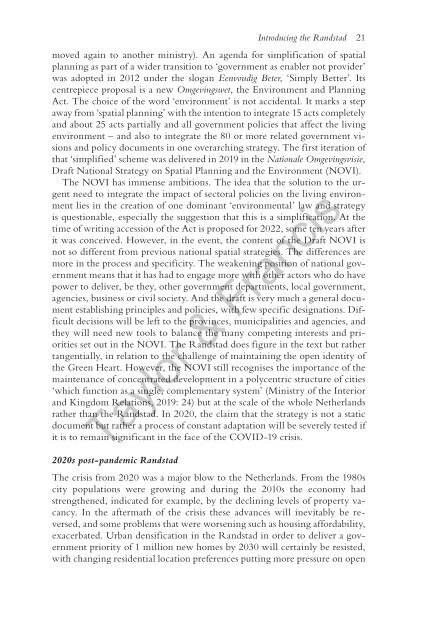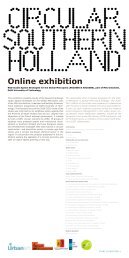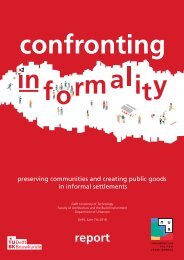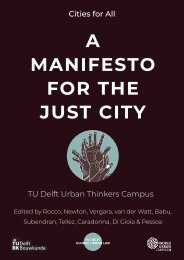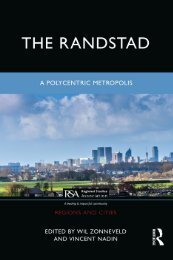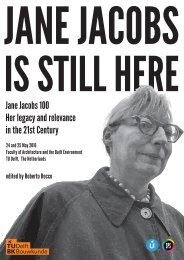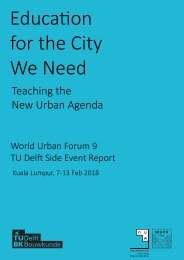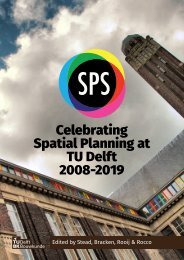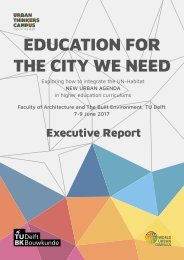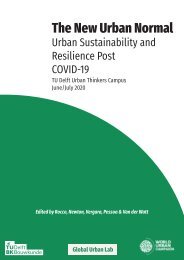The Randstad, a polycentric metropolis, by Vincent Nadin & Will Zonneveld. (Introduction Chapter)
Introduction The Randstad is a cluster of relatively medium-sized and small cities in the western Netherlands that encircles an expanse of largely open land. It is undoubtedly an important urban region, hosting in an area of about 7,000 km2, Europe’s largest seaport, third busiest airport, second largest Internet Exchange, and about 7 million people. But the Randstad is much more than this. Since the 1960s, it has acquired distinction as the archetypal polycentric metropolis, an integrated urban ring around a Green Heart, with the status of a world-class metropolitan region. There is a presumption too, that government has played an inf luential role in strengthening the polycentricity of the region, especially through its renowned capability in spatial planning. But the reality of the polycentric Randstad as opposed to the idea is controversial, as is the role of spatial planning. Do the interconnections between the four main cities – Amsterdam, The Hague, Rotterdam, and Utrecht – and the many smaller settlements in-between function as an integrated polycentric region? Does the economic and social performance of the combined whole of the Randstad add up to more than the sum of its parts? Advocates point to the apparent complementarity of the main cities with a tendency for business and financial functions to be centred in Amsterdam, port and logistics in Rotterdam, governance and international justice in The Hague, and research and development in Utrecht. Critics draw attention to the relatively limited f lows of commuters between the cities, and the concentration of the daily urban f lows within the individual city-regions, which they argue operate independently.
Introduction
The Randstad is a cluster of relatively medium-sized and small cities in the
western Netherlands that encircles an expanse of largely open land. It is undoubtedly
an important urban region, hosting in an area of about 7,000 km2,
Europe’s largest seaport, third busiest airport, second largest Internet Exchange,
and about 7 million people. But the Randstad is much more than
this. Since the 1960s, it has acquired distinction as the archetypal polycentric
metropolis, an integrated urban ring around a Green Heart, with the status of
a world-class metropolitan region. There is a presumption too, that government
has played an inf luential role in strengthening the polycentricity of the
region, especially through its renowned capability in spatial planning.
But the reality of the polycentric Randstad as opposed to the idea is controversial,
as is the role of spatial planning. Do the interconnections between the
four main cities – Amsterdam, The Hague, Rotterdam, and Utrecht – and
the many smaller settlements in-between function as an integrated polycentric
region? Does the economic and social performance of the combined
whole of the Randstad add up to more than the sum of its parts? Advocates
point to the apparent complementarity of the main cities with a tendency for
business and financial functions to be centred in Amsterdam, port and logistics
in Rotterdam, governance and international justice in The Hague, and
research and development in Utrecht. Critics draw attention to the relatively
limited f lows of commuters between the cities, and the concentration of the
daily urban f lows within the individual city-regions, which they argue operate
independently.
Create successful ePaper yourself
Turn your PDF publications into a flip-book with our unique Google optimized e-Paper software.
Introducing the <strong>Randstad</strong> 21<br />
moved again to another ministry). An agenda for simplification of spatial<br />
planning as part of a wider transition to ‘government as enabler not provider’<br />
was adopted in 2012 under the slogan Eenvoudig Beter, ‘Simply Better’. Its<br />
centrepiece proposal is a new Omgevingswet, the Environment and Planning<br />
Act. <strong>The</strong> choice of the word ‘environment’ is not accidental. It marks a step<br />
away from ‘spatial planning’ with the intention to integrate 15 acts completely<br />
and about 25 acts partially and all government policies that affect the living<br />
environment – and also to integrate the 80 or more related government visions<br />
and policy documents in one overarching strategy. <strong>The</strong> first iteration of<br />
that ‘simplified’ scheme was delivered in 2019 in the Nationale Omgevingsvisie,<br />
Draft National Strategy on Spatial Planning and the Environment (NOVI).<br />
<strong>The</strong> NOVI has immense ambitions. <strong>The</strong> idea that the solution to the urgent<br />
need to integrate the impact of sectoral policies on the living environment<br />
lies in the creation of one dominant ‘environmental’ law and strategy<br />
is questionable, especially the suggestion that this is a simplification. At the<br />
time of writing accession of the Act is proposed for 2022, some ten years after<br />
it was conceived. However, in the event, the content of the Draft NOVI is<br />
not so different from previous national spatial strategies. <strong>The</strong> differences are<br />
more in the process and specificity. <strong>The</strong> weakening position of national government<br />
means that it has had to engage more with other actors who do have<br />
power to deliver, be they, other government departments, local government,<br />
agencies, business or civil society. And the draft is very much a general document<br />
establishing principles and policies, with few specific designations. Difficult<br />
decisions will be left to the provinces, municipalities and agencies, and<br />
they will need new tools to balance the many competing interests and priorities<br />
set out in the NOVI. <strong>The</strong> <strong>Randstad</strong> does figure in the text but rather<br />
tangentially, in relation to the challenge of maintaining the open identity of<br />
the Green Heart. However, the NOVI still recognises the importance of the<br />
maintenance of concentrated development in a <strong>polycentric</strong> structure of cities<br />
‘which function as a single, complementary system’ (Ministry of the Interior<br />
and Kingdom Relations, 2019: 24) but at the scale of the whole Netherlands<br />
rather than the <strong>Randstad</strong>. In 2020, the claim that the strategy is not a static<br />
document but rather a process of constant adaptation will be severely tested if<br />
it is to remain significant in the face of the COVID-19 crisis.<br />
Taylor & Francis<br />
2020s post-pandemic <strong>Randstad</strong><br />
<strong>The</strong> crisis from 2020 was a major blow to the Netherlands. From the 1980s<br />
city populations were growing and during the 2010s the economy had<br />
strengthened, indicated for example, <strong>by</strong> the declining levels of property vacancy.<br />
In the aftermath of the crisis these advances will inevitably be reversed,<br />
and some problems that were worsening such as housing affordability,<br />
exacerbated. Urban densification in the <strong>Randstad</strong> in order to deliver a government<br />
priority of 1 million new homes <strong>by</strong> 2030 will certainly be resisted,<br />
with changing residential location preferences putting more pressure on open


